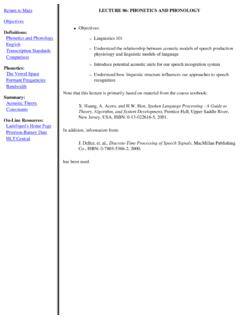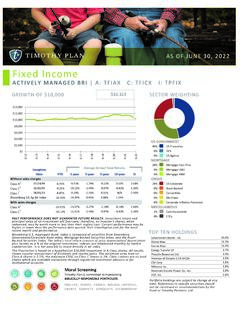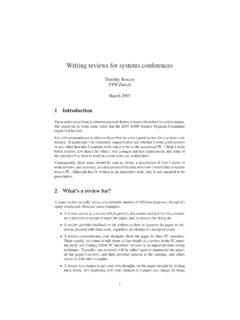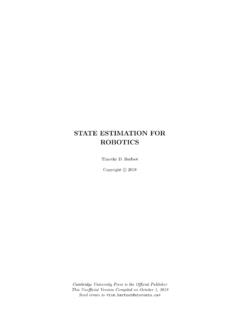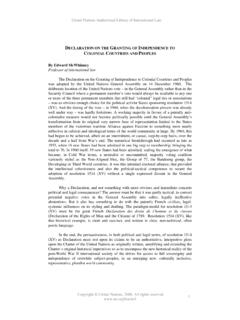Transcription of Digital Filter Design Using Matlab By Timothy J ...
1 Digital Filter Design Using MatlabBy Timothy J. SchlichterEE 4000 Introduction to Digital Filtering5/2/99 Submitted to: Dr. Joseph PiconeMississippi State UniversityDepartment of Electrical and Computer EngineeringEXECUTIVE SUMMARYA fundamental aspect of signal processing is filtering. Filtering involves the manipulationof the spectrum of a signal by passing or blocking certain portions of the spectrum,depending on the frequency of those portions. Filters are designed according to what kindof manipulation of the signal is required for a particular application. Digital filters areimplemented Using three fundamental building blocks: an adder, a multiplier, and a Design process of a Digital Filter is long and tedious if done by hand.
2 With the aid ofcomputer programs performing Filter Design algorithms, designing and optimizing filterscan be done relatively quickly. This paper discusses the use of Matlab , a mathematicalsoftware package, to Design , manipulate, and analyze Digital Design options in Matlab allow the user to either create a code for designing filtersthat calls built-in functions, or to Design filters in Sptool, a graphical user interface. Eachof these methods are examined in this paper. The strengths and weaknesses of each aredetailed in the following paper concludes with a discussion of how the data given by Matlab for various filterscan be used to implement filters on real Digital signal processors.
3 Matlab provides all theinformation necessary for building a hardware replica of the Filter designed in OF CONTENTS1. Introduction..43. Lowpass Filter Highpass and Bandpass Filter Future provides different options for Digital Filter Design , which include function calls tofilter algorithms and a graphical user interface called Sptool. A variety of Filter designalgorithms are available in Matlab for both IIR and FIR filters. This paper discusses thedifferent options in Matlab and gives examples of lowpass, highpass, and bandpass show that the graphical user interface Sptool is a quicker and simpler option thanthe option of making function calls to the Filter algorithms.
4 Sptool has a more user-friendly environment since the spectrum of the Filter is immediately displayed to the user,and the user can quickly zoom in and examine particular areas of interest in the spectrum( the passband). However, the shortcoming of Sptool is that it only displays themagnitude response of the Filter , not the phase key element in processing Digital signals is the Filter . Filters perform directmanipulations on the spectra of signals. To completely describe Digital filters, three basicelements (or building blocks) are needed: an adder, a multiplier, and a delay element. Theadder has two inputs and one output, and it simply adds the two inputs together.
5 Themultiplier is a gain element, and it multiplies the input signal by a constant. The delayelement delays the incoming signal by one sample. Digital filters can be implementedusing either a block diagram or a signal flow graph. Figure 1 shows the three basicelements in block diagram form, and Figure 2 shows them in signal flow graph form.+x(n)y(n)z(n) = x(n) + y(n)x(n)aax(n)x(n)z^-1x(n-1)ADDERMULTIPL IERDELAYF igure 1: Block Diagram of Filter Elementsx(n)y(n)z(n) = x(n) + y(n)x(n)aax(n)x(n)z^-1x(n-1)ADDERMULTIPL IERDELAYF igure 2: Signal Flow Graph of Filter ElementsWith the basic building blocks at hand, the two different Filter structures can easily beimplemented.
6 These two structures are Infinite Impulse Response (IIR) and FiniteImpulse Response (FIR), depending on the form of the system s response to a unit pulseinput. IIR filters are commonly implemented Using a feedback (recursive) structure, whileFIR filters usually require no feedback (non-recursive).In the Design of IIR filters, a commonly used approach is called the bilineartransformation. This Design begins with the transfer function of an analog Filter , thenperforms a mapping from the s-domain to the z-domain. Using differential equations, itcan be shown (Proakis 677) that the mapping from the s-plane to the z-plane issTzz= + 21111 This mapping results in a general form for an IIR Filter with an arbitrary number of polesand zeros.
7 The system response and the difference equation for this Filter is as follows:HzBzAzbzazbbzbzaza zannnMnnnNMMNN()()()..,===++++++= = = 0001111011(Ingle 183) ynbxnmaynmmmnNmM()()()= == 00 This system response can be easily realized Using a signal flow (n)y(n)b0b1b2b3b4-a1-a2-a3-a4z^-1z^-1z^- 1z^-1 Figure 3: Signal Flow Graph of IIR FilterAn FIR Filter has a difference equation ofynbxn kkkM()()= = 01 (Proakis 620)By taking the z-transform, the system response isHz b bzb zbzMMkkkM( )..=+ + += = 0111101(Ingle 197)The realization of an FIR Filter Using a signal flow graph is (n)z^-1z^-1z^-1z^-1b0b1b2b3b4y(n)Figure 4: Signal Flow Graph of FIR FilterMatlab has several Design algorithms that can be used to create and analyze both IIR andFIR Digital filters.
8 The IIR filters that can be created in Matlab are Butterworth,Chebyshev type 1 and 2, and elliptic. The FIR Filter algorithms in Matlab are equiripple,least squares, and Kaiser window. The Matlab code required to implement these filtersinvolves bilinear transformations and function calls to analog prototype filters. Thefollowing sections give examples of Matlab implementation of the IIR filters listed Filter DesignUsing Matlab , a lowpass Digital Filter is designed Using various analog prototypes:Chebyshev, Butterworth, and Elliptic. The optimum Filter type is chosen on the basis ofimplementation complexity, magnitude response, and phase response. The designspecifications for the Filter are as follows: Cutoff frequency = 1000Hz Sample frequency = 8000Hz Passband ripple= Stopband 60dB Transition band= 100 HzMatlab Code (Chebyshev):% Lowpass Digital Filter with Chebyshev-I analog prototype%% Digital Filter Specifications:wp = *2*pi;% Digital passband frequency in Hz (normalized)ws = *2*pi;% Digital stopband frequency in Hz (normalized)Rp = ;% passband ripple in dBAs = 20;% stopband attenuation in dB% Analog Prototype Specifications:Fs = 1; T = 1/Fs;OmegaP = (2/T)*tan(wp/2);% prewarp prototype passband frequencyOmegaS = (2/T)*tan(ws/2).
9 % prewarp prototype stopband frequency% Analog Chebyshev-1 Prototype Filter Calculation:[c, d] = chb1(OmegaP, OmegaS, Rp, As);% Bilinear Transformation:[b, a] = bilinear(cs, ds, Fs);%[db,mag,pha,grd,w] = freqz(b,a);plot(w*8000/2/pi,db);xlabel(' frequency (Hz)'); ylabel('decibels'); title('Magnitude indB');This exact code is also used for the elliptic and Butterworth designs. The only change isin the Filter calculations of each type. Instead of calling chb1(), the elliptic Filter designcalls a function elliptic() and the Butterworth Design calls a function butterworth() . See the appendix for the Matlab code of the function chb1().The following figures show the magnitude and phase responses of each type of (Hz)decibelsM agnitude Response of Chebyshev Filter050010001500-1-0.
10 8-0. 6-0. 4-0. (Hz)phase (norm aliz ed pi)P hase of Cheby shev Filter050010001500-60-50-40-30-20-100fre quency (Hz)decibelsM agnitude Response of Elliptic Filter050010001500-1-0 .8-0 .6-0 .4-0 . (Hz)phas e (norm aliz ed pi)P has e of E lliptic F ilter050010001500-60-50-40-30-20-100freq uencydecibelsM agnitude Response of Butterworth Filter050010001500-1-0 .8-0 .6-0 .4-0 . (norm alized pi)P has e of B utterworth FilterThe Matlab code outputs the Filter order and the Filter coefficients. For this example, theChebyshev Filter order was nine. The elliptic Filter had an order of five, and theButterworth Filter order was conclusions can be drawn about these low-pass Filter designs from this simpleexample.
